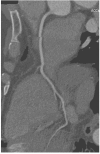Coronary CT angiography with prospective ECG-triggering: an effective alternative to invasive coronary angiography
- PMID: 24282694
- PMCID: PMC3839169
- DOI: 10.3978/j.issn.2223-3652.2012.02.04
Coronary CT angiography with prospective ECG-triggering: an effective alternative to invasive coronary angiography
Abstract
Despite the tremendous contributions of coronary CT angiography to coronary artery disease, radiation dose associated with coronary CT angiography has raised serious concerns in the literature, as the risk of developing radiation-induced malignancy is not negligible. Various dose-saving strategies have been implemented, with some of the strategies resulting in significant dose reduction. Of these strategies, prospective ECG-triggering is one of the most effective techniques with resultant effective radiation dose similar to or even lower than that of invasive coronary angiography. Prospective ECG-triggered coronary CT angiography has been reported to have high diagnostic accuracy in the diagnosis of coronary artery disease with image quality comparable to that of retrospective ECG-gating, but with significantly reduced radiation dose. Successful performance of prospective ECG-triggering is determined by strict exclusion criteria and careful patient preparation. The aim of this article is to provide an overview of the diagnostic applications of coronary CT angiography with prospective ECG-triggering with focus on radiation dose reduction. Radiation dose measurements are discussed with aim of allowing accurate dose estimation. Diagnostic value of prospective ECG-triggered coronary CT angiography in patients with different heart rate is discussed. Finally, current status and future directions are highlighted.
Keywords: Coronary artery disease; coronary CT angiography; image quality; prospective ECG-triggering; radiation dose.
Figures






Similar articles
-
Diagnostic accuracy of sub-mSv prospective ECG-triggering cardiac CT in young infant with complex congenital heart disease.Int J Cardiovasc Imaging. 2016 Jun;32(6):991-8. doi: 10.1007/s10554-016-0854-8. Epub 2016 Feb 20. Int J Cardiovasc Imaging. 2016. PMID: 26897005
-
Comparison of image quality and radiation dose between prospectively ECG-triggered and retrospectively ECG-gated CT angiography: Establishing heart rate cut-off values in first-generation dual-source CT.Anatol J Cardiol. 2015 Sep;15(9):759-64. doi: 10.5152/akd.2014.5720. Epub 2015 Jan 7. Anatol J Cardiol. 2015. PMID: 25592108 Free PMC article.
-
Submillisievert coronary CT angiography with adaptive prospective ECG-triggered sequence acquisition and iterative reconstruction in patients with high heart rate on the dual-source CT.J Xray Sci Technol. 2016 Nov 22;24(6):807-820. doi: 10.3233/XST-160589. J Xray Sci Technol. 2016. PMID: 27612046 Clinical Trial.
-
Coronary CT angiography: current status and continuing challenges.Br J Radiol. 2012 May;85(1013):495-510. doi: 10.1259/bjr/15296170. Epub 2012 Jan 17. Br J Radiol. 2012. PMID: 22253353 Free PMC article. Review.
-
Head-to-head comparison of prospectively triggered vs retrospectively gated coronary computed tomography angiography: Meta-analysis of diagnostic accuracy, image quality, and radiation dose.Am Heart J. 2013 Feb;165(2):154-63.e3. doi: 10.1016/j.ahj.2012.10.026. Epub 2012 Nov 26. Am Heart J. 2013. PMID: 23351817 Review.
Cited by
-
Seismocardiography-Based Cardiac Computed Tomography Gating Using Patient-Specific Template Identification and Detection.IEEE J Transl Eng Health Med. 2017 Jul 7;5:1900314. doi: 10.1109/JTEHM.2017.2708100. eCollection 2017. IEEE J Transl Eng Health Med. 2017. PMID: 28845370 Free PMC article.
-
Coronary Atherosclerosis Imaging.Diagnostics (Basel). 2020 Jan 24;10(2):65. doi: 10.3390/diagnostics10020065. Diagnostics (Basel). 2020. PMID: 31991633 Free PMC article. Review.
-
Cardiac computed tomography: Current practice, guidelines, applications, and prospects.Tzu Chi Med J. 2025 Mar 5;37(2):145-151. doi: 10.4103/tcmj.tcmj_125_24. eCollection 2025 Apr-Jun. Tzu Chi Med J. 2025. PMID: 40321959 Free PMC article. Review.
-
Role of Computed Tomography in Postoperative Follow-up of Arterial Switch Operation.J Cardiovasc Imaging. 2021 Jan;29(1):1-19. doi: 10.4250/jcvi.2020.0106. J Cardiovasc Imaging. 2021. PMID: 33511796 Free PMC article. Review.
-
'Longitudinal' topics in Cardiovascular Diagnosis and Therapy (CDT).Cardiovasc Diagn Ther. 2012 Jun;2(2):83-4. doi: 10.3978/j.issn.2223-3652.2012.06.02. Cardiovasc Diagn Ther. 2012. PMID: 24282701 Free PMC article. No abstract available.
References
-
- Sun Z, Lin C, Davidson R, et al. Diagnostic value of 64-slice CT angiography in coronary artery disease: a systematic review. Eur J Radiol 2008;67:78-84 - PubMed
-
- Vanhoenacker PK, Heijenbrok-Kal MH, Van Heste R, et al. Diagnostic performance of multidetector CT angiography for assessment of coronary artery disease: meta-analysis. Radiology 2007;244:419-28 - PubMed
-
- Abdulla J, Abildstrom SZ, Gotzsche O, et al. 64-multislice detector computed tomography coronary angiography as potential alternative to conventional coronary angiography: a systematic review and meta-analysis. Eur Heart J 2007;28:3042-50 - PubMed
-
- Mowatt G, Cook JA, Hillis GS, et al. 64-Slice computed tomography angiography in the diagnosis and assessment of coronary artery disease: systematic review and meta-analysis. Heart 2008;94:1386-93 - PubMed
-
- Stein PD, Yaekoub AY, Matta F, et al. 64-slice CT for diagnosis of coronary artery disease: a systematic review. Am J Med 2008;121:715-25 - PubMed
Publication types
LinkOut - more resources
Full Text Sources
